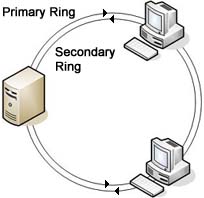Thick Coaxial Cable
This type cable is usually yellow in color and used in what is called thicknets, and has two conductors. This coax can be used in 500-meter lengths. The cable itself is made up of a solid center wire with a braided metal shield and plastic sheathing protecting the rest of the wire.Thin Coaxial Cable
As with the thick coaxial cable is used in thicknets the thin version is used in thinnets. This type cable is also used called or referred to as RG-58. The cable is really just a cheaper version of the thick cable.Fiber Optic Cable
As we all know fiber optics are pretty darn cool and not cheap. This cable is smaller and can carry a vast amount of information fast and over long distances.Twisted Pair Cables
These come in two flavors of unshielded and shielded.Shielded Twisted Pair (STP)
Is more common in high-speed networks. The biggest difference you will see in the UTP and STP is that the STP use's metallic shield wrapping to protect the wire from interference.-Something else to note about these cables is that they are defined in numbers also. The bigger the number the better the protection from interference. Most networks should go with no less than a CAT 3 and CAT 5 is most recommended.
-Now you know about cables we need to know about connectors. This is pretty important and you will most likely need the RJ-45 connector. This is the cousin of the phone jack connector and looks real similar with the exception that the RJ-45 is bigger. Most commonly your connector are in two flavors and this is BNC (Bayonet Naur Connector) used in thicknets and the RJ-45 used in smaller networks using UTP/STP.
Unshielded Twisted Pair (UTP)
This is the most popular form of cables in the network and the cheapest form that you can go with. The UTP has four pairs of wires and all inside plastic sheathing. The biggest reason that we call it Twisted Pair is to protect the wires from interference from themselves. Each wire is only protected with a thin plastic sheath.Ethernet Cabling
Now to familiarize you with more on the Ethernet and it's cabling we need to look at the 10's. 10Base2, is considered the thin Ethernet, thinnet, and thinwire which uses light coaxial cable to create a 10 Mbps network. The cable segments in this network can't be over 185 meters in length. These cables connect with the BNC connector. Also as a note these unused connection must have a terminator, which will be a 50-ohm terminator.10Base5, this is considered a thicknet and is used with coaxial cable arrangement such as the BNC connector. The good side to the coaxial cable is the high-speed transfer and cable segments can be up to 500 meters between nodes/workstations. You will typically see the same speed as the 10Base2 but larger cable lengths for more versatility.
10BaseT, the “T” stands for twisted as in UTP (Unshielded Twisted Pair) and uses this for 10Mbps of transfer. The down side to this is you can only have cable lengths of 100 meters between nodes/workstations. The good side to this network is they are easy to set up and cheap! This is why they are so common an ideal for small offices or homes.
100BaseT, is considered Fast Ethernet uses STP (Shielded Twisted Pair) reaching data transfer of 100Mbps. This system is a little more expensive but still remains popular as the 10BaseT and cheaper than most other type networks. This on of course would be the cheap fast version.
10BaseF, this little guy has the advantage of fiber optics and the F stands for just that. This arrangement is a little more complicated and uses special connectors and NIC's along with hubs to create its network. Pretty darn neat and not to cheap on the wallet.
An important part of designing and installing an Ethernet is selecting the appropriate Ethernet medium. There are four major types of media in use today: Thickwire for 10BASE5 networks, thin coax for 10BASE2 networks, unshielded twisted pair (UTP) for 10BASE-T networks and fiber optic for 10BASE-FL or Fiber-Optic Inter-Repeater Link (FOIRL) networks. This wide variety of media reflects the evolution of Ethernet and also points to the technology's flexibility. Thickwire was one of the first cabling systems used in Ethernet but was expensive and difficult to use. This evolved to thin coax, which is easier to work with and less expensive.


 Token Ring
Token Ring FDDI
FDDI
 Network can be divided in to two main categories:
Network can be divided in to two main categories: